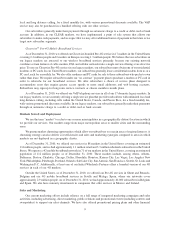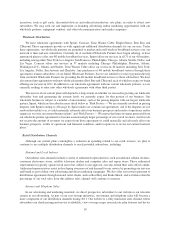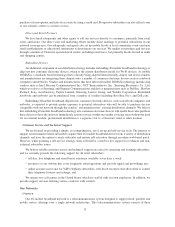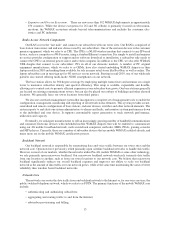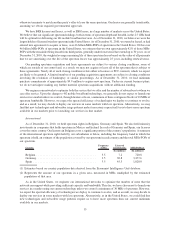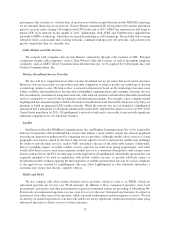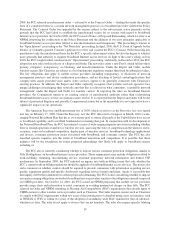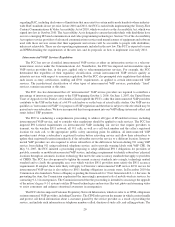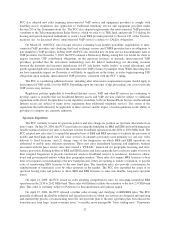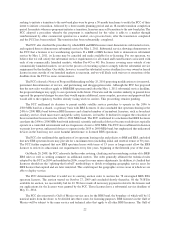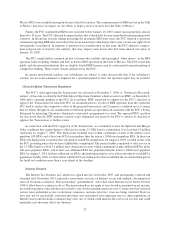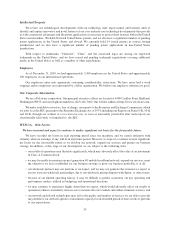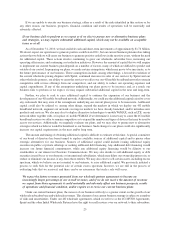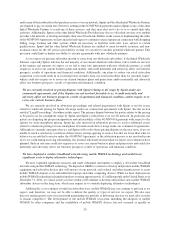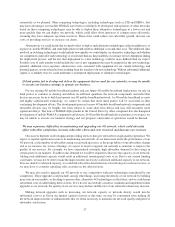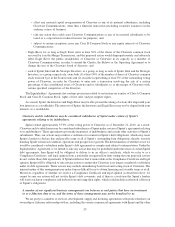Clearwire 2010 Annual Report Download - page 24
Download and view the complete annual report
Please find page 24 of the 2010 Clearwire annual report below. You can navigate through the pages in the report by either clicking on the pages listed below, or by using the keyword search tool below to find specific information within the annual report.2008, the FCC released an enforcement order — referred to as the Comcast Order — finding that under the specific
facts of a complaint before it, a certain network management practice of a broadband provider violated the Policy
Statement. The Comcast Order was appealed by the carriers subject to the enforcement action primarily on the
grounds that the FCC had failed to establish the jurisdictional source for its actions with regard to broadband
Internet access providers. In October 2009, the FCC issued a Notice of Proposed Rulemaking, which we refer to as
NPRM, proposing the codification of the Policy Statement and the addition of two new principles applicable to
broadband Internet access providers related to non-discrimination and transparency. This proceeding is known as
the “Open Internet” proceeding or the “Net Neutrality” proceeding. In April, 2010, the U.S. Court of Appeals for the
District of Columbia granted Comcast’s petition for review and vacated the FCC’s Comcast Order throwing into
question not only the jurisdictional basis for the FCC’s specific enforcement action, but also the degree to which it
more generally had authority to regulate broadband Internet access services. In light of the court’s ruling, in July
2010, the FCC sought further comment in its “Open Internet” proceeding, and finally, in December 2010, the FCC
adopted its new rules with its release of a Report and Order. The new rules create a new Part 8, which fall into three
primary categories: transparency; no blocking, and non-discrimination. Under the Report and Order, mobile
wireless carriers like Clearwire are subject to a less burdensome regulatory regime than fixed broadband providers.
The key obligations that apply to mobile service providers, including transparency, or disclosure of network
management practices and device certification procedures, and no blocking of lawful content/applications that
compete with carrier provided voice and/or video services, appear to be generally consistent with Clearwire’s
existing practices. In addition, the Report and Order explicitly recognizes that wireless network operators face
unique challenges in managing their networks and that this is reflected in what constitutes “reasonable network
management’ under the Report and Order for wireless carriers. In imposing the rules on broadband Internet
providers, the Commission turned to its existing sources of jurisdictional authority rather than reclassifying
broadband Internet access service as common carrier service. It is expected that the Report and Order will be the
subject of protracted litigation and, possibly Congressional action, but in the meanwhile it is not expected to have a
significant impact on our operations.
The American Recovery and Reinvestment Act of 2009, which we refer to as the Recovery Act, was signed
into law on February 17, 2009. Under the Recovery Act, the FCC delivered to Congress in March, 2010 a wide-
ranging National Broadband Plan that has as its statutory goal to ensure all people of the United States have access
to broadband capability and to establish benchmarks for meeting that goal. In conjunction with its development of
the National Broadband Plan, the FCC has initiated a series of wide-ranging inquiries into issues including whether
there is enough spectrum available for wireless services, assessing the state of competition in the wireless sector,
economic issues in broadband competition, deployment of wireless services, broadband technology applications
and devices, consumer protection issues associated with broadband; and consumer content. The FCC has also
launched specific inquiries into the status of broadband innovation and competition. It is possible that these
inquiries will be the foundation for future proposed rulemakings that likely will apply to broadband carriers
including us.
The FCC also is currently considering whether to impose various consumer protection obligations, similar to
Title II obligations, on broadband Internet access providers. These requirements may include obligations related to
truth-in-billing, slamming, discontinuing service, customer proprietary network information and federal USF
mechanisms. In September 2009, the FCC initiated an inquiry into truth-in-billing issues that asks whether the
FCC’s current truth-in-billing regulations should be applied to broadband Internet access services. The notice also
seeks comment on whether carriers should be required to provide consumers with information regarding service
quality, equipment quality and specific disclosures regarding service features and plans. Again, it is possible that
this inquiry will be the foundation for a future proposed rulemaking. The FCC is also considering whether to impose
automatic roaming obligations on wireless broadband service providers similar to the obligations currently imposed
on CMRS providers. On October 14, 2010, the FCC issued an NPRM proposing that mobile service providers
provide usage alerts and information to assist consumers in avoiding unexpected charges on their bills. The FCC
released an Order and NPRM extending its Hearing Aid Compatibility (HAC) requirements that already apply to
CMRS carriers to other wireless service providers such as Clearwire. The Order requires carriers such as Clearwire
to comply with HAC requirements within two years of the introduction of a handset using a new air interface, such
as WiMAX or WiFi or within two years of the adoption of an industry-wide HAC standard for that air interface,
whichever is later. The rules do not apply to devices that are not handsets. The rules also require specific labeling
19


